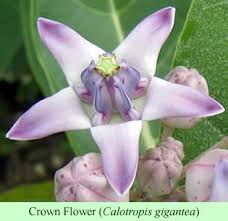http://www.sidhhaherbs.blogspot.com எருக்கம் செடி
Calotropis gigantea (Crown flower) is a species of Calotropis
native to Indonesia, Malaysia, Philippines, Thailand, Sri
Lanka, India, and China
 Calotropis grows wild up to 900 meters throughout the
country on a variety of soils in different climates, sometimes where nothing
else grows.
Calotropis grows wild up to 900 meters throughout the
country on a variety of soils in different climates, sometimes where nothing
else grows.
 நீல எருக்கு,ராம எருக்கு என ஒன்பது வகையான எருக்குகள் இருக்கின்றன என சித்தவைத்தியர்கள் கூறுகின்றனர்.எருக்கஞ்செடி 12 ஆண்டுகள் மழையில்லாமல் இருந்தாலும் கூட,சூரிய ஒளியிலுள்ள தண்ணீரை கிரகித்து வளரும் தன்மை கொண்டது.அதன் பருவகாலத்தில் பூத்து,காய்த்து,வளர்ந்துவிடும்.இதில் விஷேச அம்சம் கொண்டதுதான் வெள்ளெருக்கு.இதை வீட்டிலும் வளர்க்கலாம்.இதன் பூவை வைத்து விநாயகருக்கும்,சிவனுக்கும் அர்ச்சனை செய்யலாம்.வெள்ளெருக்கம் பூ சங்கை பஸ்மமாக்கப் பயன்படுகிறது.வெள்ளெருக்கு பட்டையை நூலுக்குப் பதில் விளக்குத்திரியாக போட்டு வீட்டில் எரிக்க சகல பூதங்களும் விலகி ஓடும்.வெள்ளெருக்கு வடவேரில் மணிமாலை செய்யலாம்.விநாயகர் செய்து வழிபடலாம்.ஆகர்ஷணம் எட்டு வகைப்படும்.இதில் தன ஆகர்ஷணம் பண வரவை அள்ளிக் கொடுக்கக் கூடியது இந்த வெள்ளெருக்கு விநாயகர்..
நீல எருக்கு,ராம எருக்கு என ஒன்பது வகையான எருக்குகள் இருக்கின்றன என சித்தவைத்தியர்கள் கூறுகின்றனர்.எருக்கஞ்செடி 12 ஆண்டுகள் மழையில்லாமல் இருந்தாலும் கூட,சூரிய ஒளியிலுள்ள தண்ணீரை கிரகித்து வளரும் தன்மை கொண்டது.அதன் பருவகாலத்தில் பூத்து,காய்த்து,வளர்ந்துவிடும்.இதில் விஷேச அம்சம் கொண்டதுதான் வெள்ளெருக்கு.இதை வீட்டிலும் வளர்க்கலாம்.இதன் பூவை வைத்து விநாயகருக்கும்,சிவனுக்கும் அர்ச்சனை செய்யலாம்.வெள்ளெருக்கம் பூ சங்கை பஸ்மமாக்கப் பயன்படுகிறது.வெள்ளெருக்கு பட்டையை நூலுக்குப் பதில் விளக்குத்திரியாக போட்டு வீட்டில் எரிக்க சகல பூதங்களும் விலகி ஓடும்.வெள்ளெருக்கு வடவேரில் மணிமாலை செய்யலாம்.விநாயகர் செய்து வழிபடலாம்.ஆகர்ஷணம் எட்டு வகைப்படும்.இதில் தன ஆகர்ஷணம் பண வரவை அள்ளிக் கொடுக்கக் கூடியது இந்த வெள்ளெருக்கு விநாயகர்..
 Calotropis yields a durable fiber (commercially known as Bowstring of India) useful for ropes, carpets, fishing nets, and sewing thread. Floss, obtained from seeds, is used for stuffing purposes.
Calotropis yields a durable fiber (commercially known as Bowstring of India) useful for ropes, carpets, fishing nets, and sewing thread. Floss, obtained from seeds, is used for stuffing purposes.

native to Indonesia, Malaysia, Philippines, Thailand, Sri
Lanka, India, and China
Calotropis gigantea.
Common names: Giant Milkweed, Crown Flower, Swallow Wort.
Plant: 2.4-3m.Common Hindi names: Aak, Alarkh, Madar, Sveta Arka.
Flower: 5.1cm across.
One of the two common species of Calotropis, native to
India. The other being Calotropis procera (Rakta Arka).
Calotropis is used as a traditional medicinal plant with
unique properties.
Traditionally Calotropis is used alone or with other medicinals to treat common diseases such as fevers, rheumatism, indigestion, cough, cold, eczema, asthma, elephantiasis, nausea, vomiting,and diarrhea. According to Ayurveda, dried whole plant is a good tonic, expectorant, depurative, and anthelmintic. The dried root bark is a substitute for ipecacuanha.
The root bark is febrifuge, anthelmintic, depurative, expectorant, and laxative.
The powdered root used in asthma, bronchitis, and dyspepsia.
The leaves are useful in the treatment of paralysis, arthralgia, swellings, and intermittent fevers. The flowers are bitter, digestive, astringent, stomachic, anthelmintic, and tonic. Calotropis is also a reputed Homoeopathic drug.
Traditionally Calotropis is used alone or with other medicinals to treat common diseases such as fevers, rheumatism, indigestion, cough, cold, eczema, asthma, elephantiasis, nausea, vomiting,and diarrhea. According to Ayurveda, dried whole plant is a good tonic, expectorant, depurative, and anthelmintic. The dried root bark is a substitute for ipecacuanha.
The root bark is febrifuge, anthelmintic, depurative, expectorant, and laxative.
The powdered root used in asthma, bronchitis, and dyspepsia.
The leaves are useful in the treatment of paralysis, arthralgia, swellings, and intermittent fevers. The flowers are bitter, digestive, astringent, stomachic, anthelmintic, and tonic. Calotropis is also a reputed Homoeopathic drug.
A fermented mixture of
Calotropis and salt is used to remove the hair from goat skins for the production
of "nari leather" and of sheep skins to make leather which is much
used for inexpensive book-binding.
Fungicidal and insecticidal properties of Calotropis have been reported
எருக்கஞ்செடி
Fungicidal and insecticidal properties of Calotropis have been reported
எருக்கஞ்செடி
BUSH TEMPALANG
A poultice of the leaves is applied for rheumatism, filariasis, wounds, glandular swellings, eczema, pigmentation, and other skin inflammations. The latex acts as a purgative, used in treating ascites of Kapha type and hepatosplenomegaly ascites.
physicianpackiam
(51)
Comments